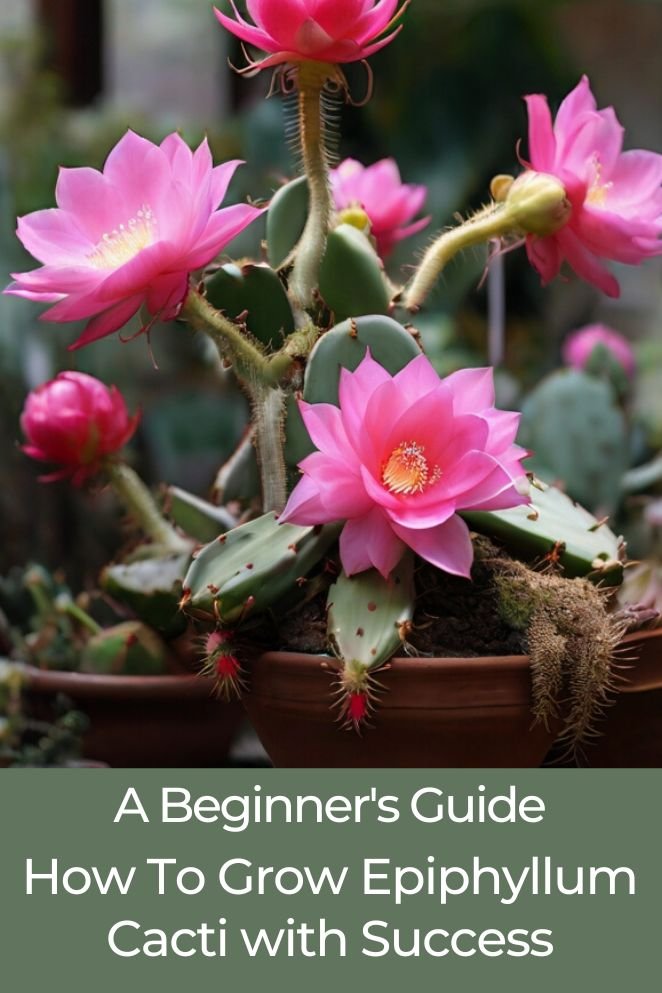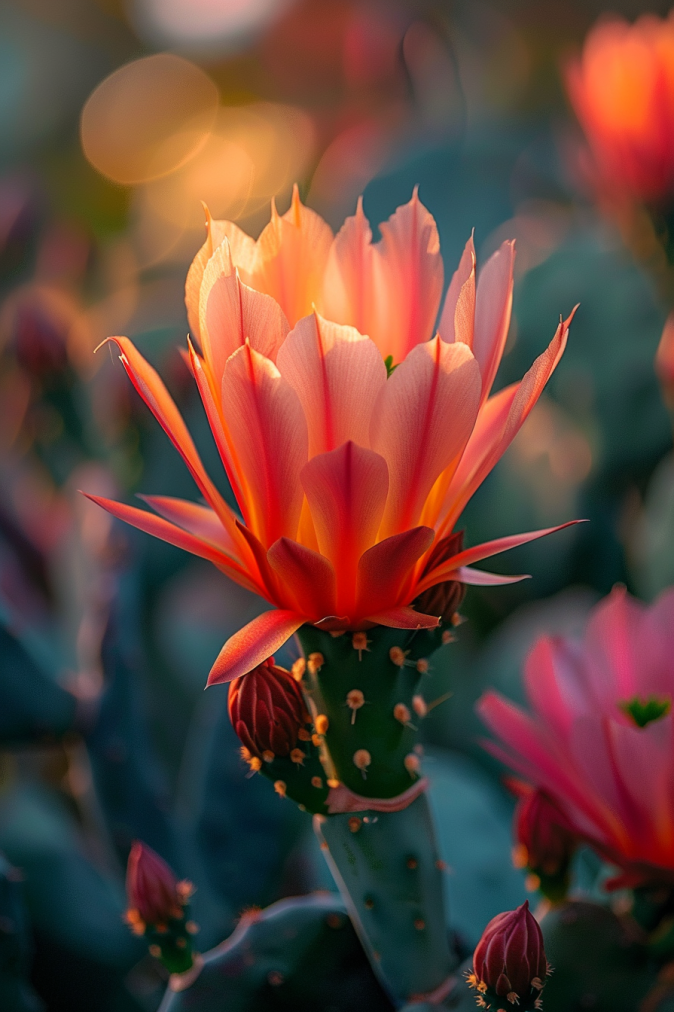
Epiphyllum cacti, also known as orchid cacti, are unique and exotic plants that add a touch of tropical beauty to any garden.
With their large, fragrant flowers and lush foliage, these cacti are a popular choice for indoor and outdoor enthusiasts alike.
In this article, we will explore the plant profile of epiphyllum cacti, and their growth requirements, and provide a comprehensive guide to their maintenance and troubleshooting.
Plant Profile
Epiphyllum cacti are native to Mexico, Central America, and South America.
These cacti are epiphytic, meaning they grow on other plants or structures rather than in the ground.
Epiphyllum cacti are known for their large, fragrant flowers, which can range in color from white to pink, red, and yellow.
- Read also: A Guide to Growing Dipladenia Plants
- Read also: Step By Step on How to Grow Blackcurrants

How to Grow Epiphyllum Cacti
Light
Epiphyllum cacti thrive in bright, indirect light, making them ideal candidates for placement near east or west-facing windows.
Direct sunlight should be avoided, as it can lead to leaf and flower scorching.
During the winter months, when daylight hours are shorter, providing supplemental lighting may be necessary to maintain optimal growth and flowering.
Temperature and humidity
Maintaining suitable temperature and humidity levels is essential for the health and vitality of Epiphyllum cacti.
During the growing season, which typically spans spring to fall, aim to keep temperatures within the range of 65-85°F (18-29°C).
In winter, when growth slows, slightly cooler temperatures of 50-60°F (10-15°C) are acceptable.
Additionally, these cacti thrive in high-humidity environments.
To increase humidity levels, mist the plant regularly or place it on a pebble tray filled with water to create a microclimate around the plant.
Soil and drainage
Providing Epiphyllum cacti with well-draining soil is crucial to prevent root rot and ensure optimal growth.
Opt for a specialized cactus and orchid mix, or create your own by combining peat moss, perlite, and bark chips.
Adding coarse sand or perlite to the soil mixture further enhances drainage, promoting healthy root development and reducing the risk of waterlogged soil.

Watering
Epiphyllum cacti have specific watering needs that should be carefully managed.
During the growing season, water the plant thoroughly when the top inch of soil feels dry to the touch, allowing excess water to drain away freely.
However, exercise caution to avoid overwatering, as this can lead to root rot.
In winter, reduce watering frequency to mimic the plant’s natural dormancy period, allowing the soil to partially dry out between waterings.
Fertilization
Regular fertilization is essential for promoting healthy growth and flowering in Epiphyllum cacti.
During the active growing season, apply a balanced liquid fertilizer diluted to half strength every 4-6 weeks.
Avoid fertilizing during the winter months when the plant is dormant.
Additionally, incorporating a layer of organic mulch around the base of the plant helps retain moisture, suppresses weeds, and provides slow-release nutrients over time.
Pruning and maintenance
Epiphyllum cacti may require occasional pruning to remove dead or damaged stems, promote branching, and maintain an attractive shape.
Use sterilized pruning shears to make clean cuts, and promptly remove any diseased or pest-infested sections to prevent spread.
Regular monitoring for pests such as scale insects or mealybugs helps prevent infestations and ensures the continued health of the plant.
Potting and repotting
Epiphyllum cacti prefer slightly cramped roots, so only repot when necessary.
Choose a pot one size larger than the current one with proper drainage.
Opt for a well-draining cactus mix. Repot in spring after blooming, allowing recovery for the active growing season.
Propagation
Epiphyllum cacti can be propagated from stem cuttings or seeds.
From stem cuttings
- Select a healthy stem with at least one node.
- Make a clean cut, and let it callus for a few days.
- Plant in well-draining soil, ensuring the buried node.
- Water lightly and place in a warm, bright, indirect light spot.
From Seeds
- Sow seeds in shallow, well-draining soil.
- Press seeds into the soil, and maintain consistent moisture.
- Place in a warm, bright location with indirect sunlight.
- Cover for humidity and uncover gradually after germination.

Maintenance and Troubleshooting
Pests and diseases
Epiphyllum cacti generally boast resistance to pests and diseases.
Despite their hardiness, common cactus nuisances like scale insects and mealybugs can pose a threat.
Vigilance is key—observe for signs of infestation, and if detected, promptly treat the cactus using horticultural oil or insecticidal soap for effective control.
Flowering
Achieving vibrant blooms with Epiphyllum cacti requires attention to their unique needs. Optimal flowering conditions include:
Lighting
- Provide bright, indirect light for the cactus, promoting robust blooming.
- Avoid exposing the plant to direct sunlight, which may lead to leaf and flower damage.
Moisture
- Maintain consistent moisture levels, especially during the growing season.
- Adequate watering contributes to healthy blooming cycles and prevents stress on the plant.
Fertilization
- Apply a balanced fertilizer during the growing season to enhance flowering.
- Choose a fertilizer specifically formulated for cacti and succulents, diluted as recommended.
Benefits of Growing Epiphyllum Cacti
Beyond their captivating night blooms and ethereal beauty, epiphyllum cacti offer a surprising number of benefits that make them well-suited for any plant enthusiast:
Aesthetics and ambiance
- Unique form and texture: Their flat, segmented stems and diverse shapes add a touch of the exotic to any space.
- Enchanting blooms: The night-blooming spectacle, often fragrant and delicate, creates a truly magical atmosphere.
- Low-maintenance beauty: They require less effort than many houseplants, making them ideal for busy individuals.
Health and wellbeing
- Air purification: Like other plants, they help filter toxins and improve indoor air quality.
- Stress reduction: Studies suggest caring for plants can decrease stress and anxiety, promoting relaxation.
- Sense of accomplishment: Witnessing the growth and blooms you nurtured brings a sense of achievement and connection with nature.
Sustainability and education
- Slow-growing and long-lived: Many varieties can live for decades, becoming treasured companions.
- Propagation potential: Sharing cuttings with friends and family fosters a sense of community and responsibility.
- Learning opportunity: Growing these unique plants encourages research and appreciation for botanical diversity.
Additional benefits
- Conversation starters: Their unusual appearance and night-blooming habit spark curiosity and interesting discussions.
- Cultural significance: In some cultures, epiphyllum cacti symbolize resilience, beauty, and good luck.
- Variety available: Choose from numerous sizes, shapes, and flower colors to suit your preference and space.

- Read also: How to Grow Gerberas: A Guide for Stunning Blooms
- Read also: How to Grow Quinces – A Guide to Successful Growth
Conclusion
Epiphyllum cacti are unique and exotic plants that add a touch of tropical beauty to any garden.
By providing the right care and maintenance, you can enjoy the beauty of these cacti for years to come.
Whether you’re a seasoned cactus enthusiast or a beginner gardener, the epiphyllum cactus is a wonderful addition to any water-wise landscape.
FAQs
They bloom at night with fragrant flowers, have unique shapes, and add tropical flair to any home.
Not really! They need specific light, water, and humidity, but overall they’re low-maintenance.
Yellowing leaves, mushy stems, and stunted growth. Water less frequently if you see these signs.
Epiphyllum cacti are prone to root rot if the soil stays soggy. Ensure good drainage with holes in the pot.



